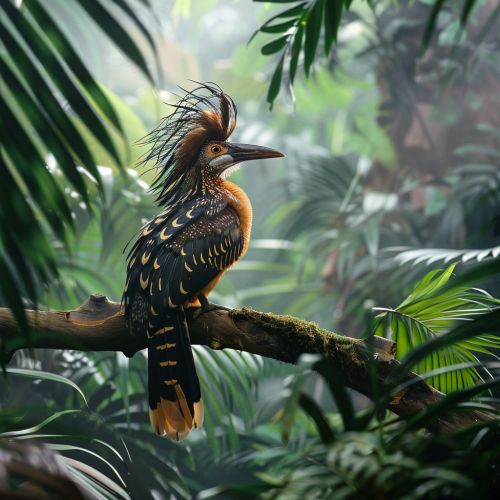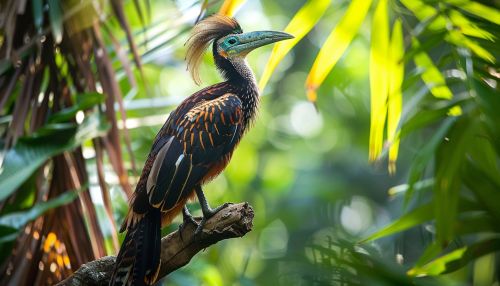Hoatzin: Difference between revisions
(Created page with "== Description == The Hoatzin (''Opisthocomus hoazin'') is a unique species of tropical bird found primarily in the swamps, riverine forests, and mangroves of the Amazon and Orinoco basins in South America. Known for its distinctive appearance and unusual digestive system, the Hoatzin is the only member of the family Opisthocomidae and the order Opisthocomiformes. This bird has intrigued ornithologists and evolutionary biologists due to its primitive charact...") |
No edit summary |
||
| Line 3: | Line 3: | ||
The [[Hoatzin]] (''Opisthocomus hoazin'') is a unique species of tropical bird found primarily in the swamps, riverine forests, and mangroves of the Amazon and Orinoco basins in South America. Known for its distinctive appearance and unusual digestive system, the Hoatzin is the only member of the family [[Opisthocomidae]] and the order [[Opisthocomiformes]]. This bird has intrigued ornithologists and evolutionary biologists due to its primitive characteristics and specialized adaptations. | The [[Hoatzin]] (''Opisthocomus hoazin'') is a unique species of tropical bird found primarily in the swamps, riverine forests, and mangroves of the Amazon and Orinoco basins in South America. Known for its distinctive appearance and unusual digestive system, the Hoatzin is the only member of the family [[Opisthocomidae]] and the order [[Opisthocomiformes]]. This bird has intrigued ornithologists and evolutionary biologists due to its primitive characteristics and specialized adaptations. | ||
[[Image:Detail-91329.jpg|thumb|center|A Hoatzin bird perched on a branch in a tropical forest.|class=only_on_mobile]] | |||
[[Image:Detail-91330.jpg|thumb|center|A Hoatzin bird perched on a branch in a tropical forest.|class=only_on_desktop]] | |||
== Taxonomy and Evolution == | == Taxonomy and Evolution == | ||
Latest revision as of 18:41, 21 June 2024
Description
The Hoatzin (Opisthocomus hoazin) is a unique species of tropical bird found primarily in the swamps, riverine forests, and mangroves of the Amazon and Orinoco basins in South America. Known for its distinctive appearance and unusual digestive system, the Hoatzin is the only member of the family Opisthocomidae and the order Opisthocomiformes. This bird has intrigued ornithologists and evolutionary biologists due to its primitive characteristics and specialized adaptations.


Taxonomy and Evolution
The Hoatzin's taxonomic classification has been a subject of debate among scientists. Initially, it was placed in the order Galliformes due to its superficial resemblance to pheasants and other game birds. However, molecular studies have shown that the Hoatzin is not closely related to any other living bird species, leading to its placement in its own order, Opisthocomiformes. The Hoatzin's evolutionary history is equally enigmatic, with fossil evidence suggesting that its lineage diverged from other birds around 64 million years ago, shortly after the Cretaceous-Paleogene extinction event.
Physical Characteristics
The Hoatzin is a medium-sized bird, measuring about 65 centimeters in length. It has a long neck, a small head adorned with a spiky crest, and red eyes. Its plumage is predominantly brown with white streaks, and it has a blue facial skin. One of the most distinctive features of the Hoatzin is its clawed wings, which are particularly prominent in chicks. These claws are used by young Hoatzins to climb trees and navigate their arboreal environment before they are capable of flight.
Unique Digestive System
The Hoatzin is renowned for its highly specialized digestive system, which is more akin to that of ruminant mammals than other birds. It primarily feeds on leaves, flowers, and fruits, and has a large, multi-chambered crop where microbial fermentation occurs. This process allows the Hoatzin to break down the tough plant material and extract nutrients. The fermentation process produces a distinctive odor, often likened to cow manure, earning the Hoatzin the nickname "stinkbird."
Behavior and Ecology
Hoatzins are social birds, often found in small family groups or larger flocks. They are primarily arboreal, spending most of their time in trees and rarely descending to the ground. Their flight is weak and clumsy, and they prefer to move by climbing and hopping among branches. Hoatzins are also known for their vocalizations, which include a variety of grunts, hisses, and croaks.
Reproduction
Hoatzins breed during the rainy season, constructing their nests in trees overhanging water. The female typically lays two to three eggs, which are incubated for about a month. Both parents share the responsibility of feeding and protecting the chicks. The young are precocial, hatching with well-developed claws on their wings, which they use to climb back to the nest if they fall into the water.
Conservation Status
The Hoatzin is currently listed as a species of Least Concern by the International Union for Conservation of Nature (IUCN). While its population is stable, the Hoatzin faces threats from habitat destruction and degradation due to deforestation and human encroachment. Conservation efforts are focused on preserving its natural habitat and ensuring the sustainability of the ecosystems it depends on.
Cultural Significance
The Hoatzin holds cultural significance for many indigenous peoples of the Amazon basin. It is often featured in local folklore and mythology, symbolizing various aspects of the natural world. Despite its unappealing odor, the Hoatzin is sometimes hunted for food, although this practice is not widespread.
